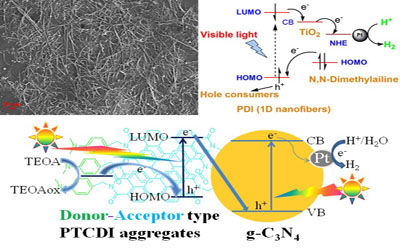Novel Perylene Diimide-based Photocatalysts for Visible-light-driven Hydrogen Evolution Help Water-splitting
Editor: | Jun 24,2015
Hydrogen (H2) is an ideal green energy source to alleviate the impact of fossil fuel scarcity and environmental risk because it is renewable, energy dense, and environmentally friendly. Splitting water using a photocatalytic reduction reaction on the semiconductor surface utilizing abundant solar energy has been recognized as one of the most promising approaches for clean, cost-effective production of H2. The discovery of high efficient visible-light-driven semiconductor photocatalysts, which is the key of this technique, still faces challenge.
A research group led by Prof. WANG Chuanyi from Xinjiang Technical Institute of Physics & Chemistry (XTIPC) of Chinese Academy of Sciences developed a series of semiconductor composites based on a kind of air-stable n-type organic semiconductor, perylene tetracarboxylic diimides (PTCDIs), as novel visible-light-responding and photochemically stable catalysts.
Through supramolecular self-assembly in solution phase, one-dimensional (1D) nanofibers of PTCDIs have been obtained and utilized to fabricate a series of novel nanocomposite semiconductor systems via in situ deposition of TiO2 layers and/or Pt (co-catalyst) nanoparticles. The researchers employed molecular aggregates of PTCDIs bearing electron-rich phenylamino or benzylamino moieties as visible-light absorbers to combine with commercial inorganic semiconductor (TiO2) nanoparticles or the most promising metal-free organic semiconductor (g-C3N4) by solution processing.
When these composite powders were suspended in aqueous solution containing methanol or triethanolamine as sacrificial electron donors, they were demonstrated as efficient photocatalysts for H2 evolution from photocatalytic water reduction under visible light (Xe lamp, λ≥ 420 nm). Researchers found that there were three key criteria for the application of PTCDI molecules in this field including the electron donor–acceptor feature of PTCDIs resulting from the presence of electron-rich 4-(dimethylamino) phenyl and 4-(dimethylamino) benzyl electron-rich moieties, bisolvent-induced π–π stacking morphology with the assistance of dodecyl medication and their well cooperation and matched energy levels with other semiconductor photocatalysts (TiO2 and g-C3N4). Photocatalyst composites of PTCDIs and g-C3N4 showed great photocatalytic H2 generation performance due to efficient inter- and intra-molecular charge transfer in organic characteristics, strong visible-light response, good stability, and economically viability.
The results have been published in the RSC Advances and Applied Catalysts A: General, providing insight to develop new semiconductor catalyst systems in the field of solar-driven photocatalytic water-splitting and expand the applied scope of 1D supramolecular nanostructures of PTCDIs. They also shed light on the development of future photoelectrocatalytic technologies for H2 production.
The work was supported by the National Natural Science Foundation of China, the Hundred Talent Program of CAS etc.

Figure:Photoinduced charge transfer between PTCDI aggregates and TiO2 or g-C3N4 under visible-light irradiation (Image by XTIPC)
Contact:
Prof. WANG Chuanyi
E-mail: cywang@ms.xjb.ac.cn
Xinjiang Technical Institute of Physics & Chemistry,CAS
附件下载:
 (86) 991-3838931
(86) 991-3838931 lhskj@ms.xjb.ac.cn
lhskj@ms.xjb.ac.cn (86)991-3838957
(86)991-3838957 40-1 Beijing Road
Urumqi, XinjiangChina
40-1 Beijing Road
Urumqi, XinjiangChina